1 Zigbee Technology Overview
This article refers to the address: http://
Zigbee technology is a short-range, low-complexity, low-power, low-data-rate, low-cost two-way wireless communication technology. It is mainly suitable for automatic control and remote control. It can be embedded in various devices and supports geolocation. . In general, as the communication distance increases, the complexity, power consumption, and system cost of the device increase. Compared to existing wireless communication technologies, Zigbee technology will be the lowest power and cost technology. At the same time, the low data rate and small communication range based on Zigbee technology also determines that Zigbee technology is suitable for carrying services with small data traffic. The main advantages of Zigbee technology are: power saving, reliability, low cost, short delay, large network capacity and security.
Zigbee is a set of technical standards related to networking, security and application software developed based on the 802.15.4 wireless standard approved by the IEEE. It is not just the name of 802.15.4. The IEEE only handles low-level MAC layers and physical layer protocols, and the Zigbee Alliance standardizes its network layer protocols and APIs. The full protocol is used for 4K bytes of a base node that can be directly connected to one device or 32 K bytes as a coordinator of a Hub or router. Each coordinator can connect up to 255 nodes, while several coordinators can form a network, and there is no limit to the number of route transfers. The Zigb ee Alliance has also developed a layer of security to ensure that such portable devices do not accidentally leak their identity, and that such long-distance transmissions over the network are not available to other nodes.
The complete Zigbee protocol suite consists of a high-level application specification, an application convergence layer, a network layer, a data link layer, and a physical layer. The network layer and above protocols are developed by the Zi gbee consortium, which is responsible for the physical layer and link layer standards. Figure 1 shows the Zigbee protocol architecture.
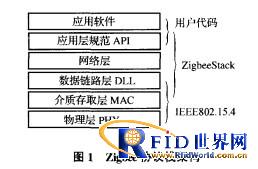
2 Zigbee's application in automobile tire pressure monitoring system
At present, the number of vehicle traffic accidents on expressways is increasing, and a large part is caused by tire puncture caused by excessive or low pressure of tires. The tire pressure monitoring system monitors the pressure in the tires around the clock, monitors and alarms the leakage, low pressure and high pressure of the tires, so that the vehicle is always in safe operation. Try to avoid traffic accidents caused by tire pressure.
Zigbee is mainly used in various electronic devices with short distance, low power consumption and low transmission rate. Typical transmission data types include periodic data, intermittent data and low response time data. It is envisaged that its application targets are: industrial control (such as automatic control equipment, wireless sensor networks), automotive wireless monitoring (such as tire pressure, temperature, etc.), medical care (such as monitoring and sensing), home intelligence control (such as lighting) , water and electricity metering and alarm), remote control devices for consumer electronic devices, wireless connection of PC peripherals, etc.
2.1 System composition and principle
The tire pressure monitoring system consists of a tire pressure sensor, a controller, a radio frequency transmitter, and a receiver. Tire Pressure Sensor The integrated capacitive pressure sensor MPXY8020A developed by Motorola is used as a tire pressure detection unit with low power consumption and full integration. The Zigbee module CC2430 is used as a signal control processing and transmitting and receiving unit.
The pressure sensor installed in each tire tire transmits the pressure and temperature information in the tire to the receiver module in the cab through the RF transmitter to transmit the tire pressure and temperature information to the driver's module. Understand the working condition of the tire, check whether the tire's air pressure and temperature are normal, and make an abnormal alarm to ensure safety. Smart tires work in conjunction with a receiver and display on the dashboard of the car to form a tire pressure monitor monitoring system (TP MS).
2.2 Application of CC2430 in vehicle detection system
The principle structure of the tire pressure detecting system with CC2430 as the core for transmitting and receiving and data processing components is shown in Fig. 2.
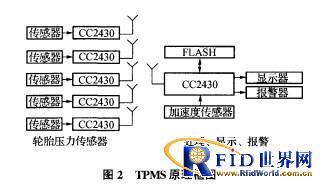
1) Processing of sensor data. The pressure sensor (Motor Part No. MP XY8020A) installed in each tire (4 wheels in the car, 1 spare wheel) is a capacitive ME MS pressure sensor designed to meet the temperature and pressure media compatibility of TP MS. Requirements. It is a single pressure and temperature sensor with power management and digital output capabilities.
2) Tire data transmission. In order to ensure the reliability of transmitting and receiving data in a harsh environment, and according to the characteristics of small amount of information and simple data of the application, information redundancy is adopted to ensure reliable reception of data, that is, information of the same content is continuously transmitted. The data is sent and processed, and the CC2430 module is used here.
3) Tire data reception. In order to reduce power and save battery power, an acceleration sensor is installed in the cab data processor. Once the vehicle is started, the pressure detecting transmitting circuit in each tire is activated, the vehicle stops, and the circuit in the tire enters a sleep mode.
4) Tire pressure display and alarm. Tire pressure and temperature data can be set in the cab controller depending on the tire type and season. The controller continuously receives tire data while the vehicle is running, and performs data analysis, storage, and display. If an abnormality occurs, the alarm prompts the driver. The data stored in the FLASH can be used for post-analysis of accidents.
2.3 CC2430 module
The CC2430 chip is supported by a powerful integrated development environment. The interactive debugging of internal lines is supported by the IDE's IAR industry standard and is highly recognized by embedded organizations. It combines Chipcon's globally advanced Zigbee protocol stack, toolkit and reference design to showcase the leading Zigbee solution. Its products are widely used in automotive, industrial control systems and wireless sensing networks, as well as other devices at 2.4 G Hz outside Zigbee.
1) Main features of CC2430 chip: high performance and low power 8051 microcontroller core: integrated 2.4GHz RF radio transceiver conforming to IEEE802.15.4 standard; excellent wireless receiving sensitivity and strong anti-interference Only 0.9 current consumption in sleep mode, external interrupt or RTC can wake up the system; less than 0.6 current consumption in standby mode, external interrupt can wake up the system; hardware supports cSMCA function; wider Voltage range (2.0 ~ 3.6V); digital RSSI / LQ1 support and powerful DMA function; battery monitoring and temperature sensing; integrated 14-bit analog-to-digital ADC; integrated AES security coprocessor; 2 powerful USARTs supporting several sets of protocols, 1 MAC timer compliant with IEEE802.15.4, 1 regular 16-bit timer and 2 8-bit timers; powerful and flexible development tools . The basic block diagram of the Zigbee of CC2430 is shown in Figure 3.
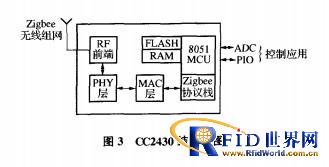
2) Typical application circuit. The typical application circuit of CC2430 is shown in Figure 4, where: Figure 4 (a) is the TP MS transmitter, Figure 4 (b) is the TP MS receiver, and Figure 4 (c) is the CC2430 module schematic. This circuit is mainly used for low power and withstand voltage monitoring systems.
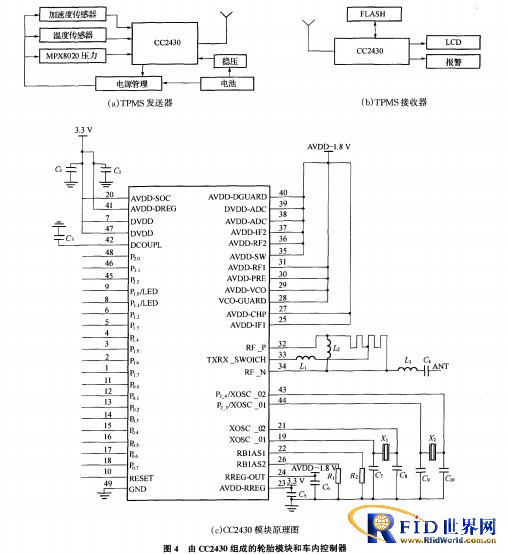
3 TPMS system software design
The software of TPMS is relatively simple. The tire monitoring module mainly measures, processes and transmits the air pressure, temperature and power voltage data. The host display module receives the data frame and displays the air pressure, temperature and voltage values ​​after verification, and compares it with the alarm threshold to determine whether an alarm is required. The whole system has very high requirements for low-power design, so the program flow should be arranged as much as possible to optimize the software algorithm. After executing the initialization function, the main program of the tire monitoring module sets the timing time according to the difference between the current air pressure value and the alarm threshold, and then enters the low power mode. The module supply voltage, tire pressure and temperature monitoring and data transmission are placed in the timing program, and the low power mode is entered immediately after the timing ends. After the host is powered on, the CC2430 is initialized. After the CC2430 is configured, the module enters the waiting data working state. After receiving a data frame and judging by the CRC check and the tire ID, the digital display is sent and the corresponding indicator light is illuminated to indicate that each module is working properly. When the tire monitoring module supply voltage, air pressure and temperature are received or below the alarm threshold, the host activates the LED flashing warning or buzzer alarm. The software flow chart of the module in the tire is shown in Figure 5. The software flow of the controller in the vehicle is shown in Figure 6.
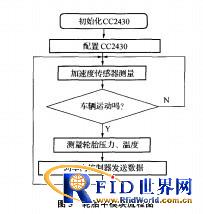
Figure 5 Module flow chart in the tire
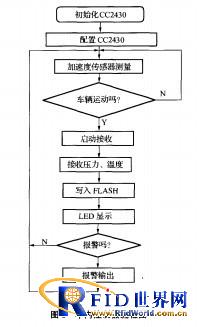
Figure 6 In-vehicle controller flow chart
In order to achieve wireless communication between the four tire modules and the central receiving module, both the transmitter and the receiver need to support a simple communication protocol as required. The tire module sends data in the form of data packets (frames). When the MCU in the tire module decides to send data (temperature and pressure data collected by the sensor), the receiving module is woken up by sending the leading position of the data frame, and then the data is sent. Frame, its data frame format is shown in Table 1.

4 Conclusion
Zigbee technology makes up for the vacancy in the low-cost, low-power and low-rate wireless communication market. It connects to various smart meters, monitoring devices and alarm devices of the car through the sensor wireless network to monitor tire pressure and early warning to avoid tire pressure. Meet the purpose of traffic accidents caused by standards. The TPMS system has the characteristics of small size, low cost and two-way full-time, and will be widely used.
Power 90W ,output voltage 15-24V, output current Max 6A, 10 dc tips.
We can meet your specific requirement of the products, like label design. The plug type is US/UK/AU/EU. The material of this product is PC+ABS. All condition of our product is 100% brand new. OEM and ODM are available in our company, and you deserve the best service. You can send more details of this product, so that we can offer best service to you!
90W Desktop Adapter,90W Desktop Power Supply,90W Desktop Power Cord , 90W Desktop Power Adapter
Shenzhen Waweis Technology Co., Ltd. , https://www.huaweishiadapter.com